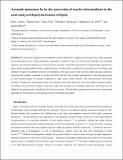Files in this item
Aromatic monomers by in situ conversion of reactive intermediates in the acid-catalyzed depolymerization of lignin
Item metadata
| dc.contributor.author | Deuss, Peter Joseph | |
| dc.contributor.author | Scott, Martin | |
| dc.contributor.author | Tran, Fanny | |
| dc.contributor.author | Westwood, Nicholas James | |
| dc.contributor.author | de Vries, Johannes G. | |
| dc.contributor.author | Barta, Katalin | |
| dc.date.accessioned | 2016-05-21T23:32:24Z | |
| dc.date.available | 2016-05-21T23:32:24Z | |
| dc.date.issued | 2015-06-17 | |
| dc.identifier | 190269053 | |
| dc.identifier | d0c6b1fd-adab-40a2-9121-fa1f5e5a34ff | |
| dc.identifier | 84934970428 | |
| dc.identifier | 000356753700033 | |
| dc.identifier.citation | Deuss , P J , Scott , M , Tran , F , Westwood , N J , de Vries , J G & Barta , K 2015 , ' Aromatic monomers by in situ conversion of reactive intermediates in the acid-catalyzed depolymerization of lignin ' , Journal of the American Chemical Society , vol. 137 , no. 23 , pp. 7456–7467 . https://doi.org/10.1021/jacs.5b03693 | en |
| dc.identifier.issn | 0002-7863 | |
| dc.identifier.other | ORCID: /0000-0003-0630-0138/work/56424139 | |
| dc.identifier.uri | https://hdl.handle.net/10023/8851 | |
| dc.description | The authors gratefully acknowledge financial support from the European Commission (SuBiCat Initial Training Network, Call FP7-PEOPLE-2013-ITN, grant no. 607044). | en |
| dc.description.abstract | Conversion of lignin into well-defined aromatic chemicals is a highly attractive goal, but is often hampered by recondensation of the formed fragments, especially in acidolysis. Here, we describe new strategies that markedly suppress such undesired pathways to result in diverse aromatic compounds previously not systematically targeted from lignin. Model studies established that a catalytic amount of triflic acid is very effective in cleaving the β-O-4 linkage, most abundant in lignin. An aldehyde product was identified as the main cause of side reactions under cleavage conditions. Capturing this unstable compound by reaction with diols and by in situ catalytic hydrogenation or decarbonylation lead to three distinct groups of aromatic compounds in high yields acetals, ethanol and ethyl aromatics, and methyl aromatics. Notably, the same product groups were obtained when these approaches were successfully extended to lignin. In addition, the formation of higher molecular weight side products was markedly suppressed, indicating that the aldehyde intermediates play a significant role in these processes. The described strategy has the potential to be generally applicable for the production of interesting aromatic compounds from lignin. | |
| dc.format.extent | 12 | |
| dc.format.extent | 1184593 | |
| dc.language.iso | eng | |
| dc.relation.ispartof | Journal of the American Chemical Society | en |
| dc.subject | QD Chemistry | en |
| dc.subject | NDAS | en |
| dc.subject | BDC | en |
| dc.subject | R2C | en |
| dc.subject.lcc | QD | en |
| dc.title | Aromatic monomers by in situ conversion of reactive intermediates in the acid-catalyzed depolymerization of lignin | en |
| dc.type | Journal article | en |
| dc.contributor.sponsor | European Commission | en |
| dc.contributor.institution | University of St Andrews. School of Chemistry | en |
| dc.contributor.institution | University of St Andrews. EaSTCHEM | en |
| dc.contributor.institution | University of St Andrews. Biomedical Sciences Research Complex | en |
| dc.identifier.doi | 10.1021/jacs.5b03693 | |
| dc.description.status | Peer reviewed | en |
| dc.date.embargoedUntil | 2016-05-22 | |
| dc.identifier.grantnumber | SUBICAT | en |
This item appears in the following Collection(s)
Items in the St Andrews Research Repository are protected by copyright, with all rights reserved, unless otherwise indicated.

